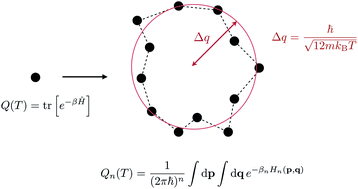当前位置:
X-MOL 学术
›
Faraday Discuss.
›
论文详情
Our official English website, www.x-mol.net, welcomes your
feedback! (Note: you will need to create a separate account there.)
Path integral methods for reaction rates in complex systems.
Faraday Discussions ( IF 3.3 ) Pub Date : 2019-12-16 , DOI: 10.1039/c9fd00084d Joseph E Lawrence 1 , David E Manolopoulos
Faraday Discussions ( IF 3.3 ) Pub Date : 2019-12-16 , DOI: 10.1039/c9fd00084d Joseph E Lawrence 1 , David E Manolopoulos
Affiliation

|
We shall use this introduction to the Faraday Discussion on quantum effects in complex systems to review the recent progress that has been made in using imaginary time path integral methods to calculate chemical reaction rates. As a result of this progress, it is now routinely possible to calculate accurate rate constants including quantum mechanical zero point energy and tunnelling effects for arbitrarily complex (anharmonic and multi-dimensional) systems. This is true in the adiabatic (Born-Oppenheimer) limit, in the non-adiabatic (Fermi Golden Rule) limit, and everywhere between these two limits in the normal Marcus regime. Quantum mechanical effects on reaction rates can be enormous, even at room temperature, and the problem of including these effects in simulations of a wide variety of chemical reactions in complex systems has now effectively been solved.
中文翻译:

复杂系统中反应速率的路径积分方法。
我们将使用法拉第讨论中关于复杂系统中量子效应的介绍来回顾使用虚构时间路径积分方法计算化学反应速率方面的最新进展。由于这一进展,现在可以常规地计算出精确的速率常数,包括量子机械零点能量和任意复杂(非谐和多维)系统的隧穿效应。在绝热(Born-Oppenheimer)极限,非绝热(Fermi黄金法则)极限以及正常马库斯体制中这两个极限之间的任何地方都是如此。即使在室温下,量子力学对反应速率的影响也可能是巨大的,
更新日期:2019-12-17
中文翻译:

复杂系统中反应速率的路径积分方法。
我们将使用法拉第讨论中关于复杂系统中量子效应的介绍来回顾使用虚构时间路径积分方法计算化学反应速率方面的最新进展。由于这一进展,现在可以常规地计算出精确的速率常数,包括量子机械零点能量和任意复杂(非谐和多维)系统的隧穿效应。在绝热(Born-Oppenheimer)极限,非绝热(Fermi黄金法则)极限以及正常马库斯体制中这两个极限之间的任何地方都是如此。即使在室温下,量子力学对反应速率的影响也可能是巨大的,











































 京公网安备 11010802027423号
京公网安备 11010802027423号